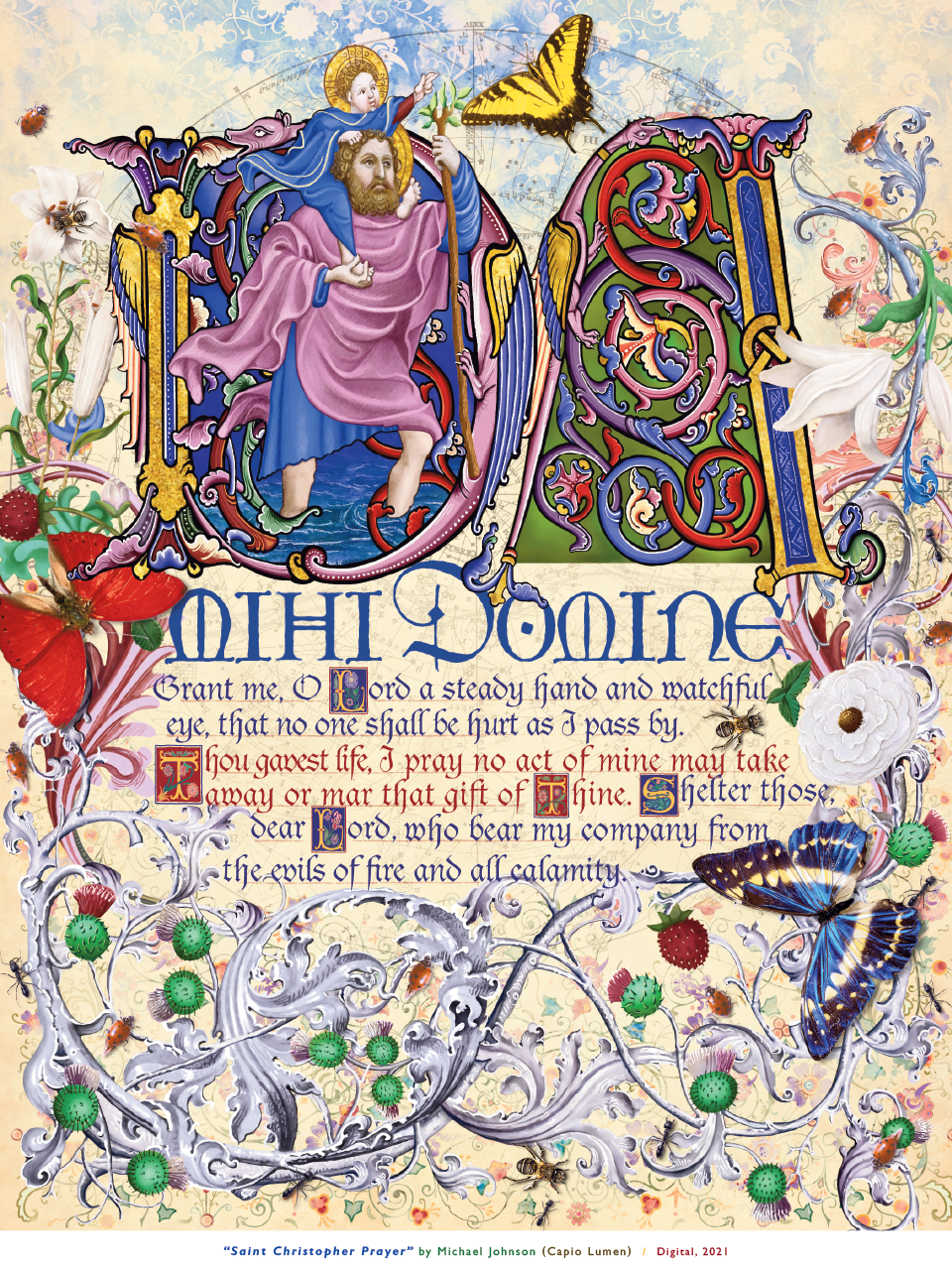
MICHAEL JOHNSON's Digital Illuminated Manuscripts on Exhibit at the Hilbert Museum of California Art
Bright flowers dance on the page, the tendrils of their vines entwining around colorful birds, butterflies and other creatures, ranging from lions to deer to roosters. A large, elaborate initial letter, itself entwined with branches and flowers, takes the center stage, framing an elegantly painted Biblical scene. Gracefully calligraphed text flows as if organically growing among the scenes of nature and faith.
These are the illuminated manuscript pages designed by Capio Lumen—Latin for “capture the light”—a pseudonym used by Orange-based artist Michael Johnson when creating his complex digital-collage artworks. His works are currently on exhibition at the Hilbert Museum of California Art at Chapman University, through May 7.
“We thought Michael’s works were exquisitely beautiful and like nothing we’d ever seen before in the digital-art realm,” says Mary Platt, Director of the Hilbert Museum. “He’d never had a museum exhibition before, and we had never shown a digital-art exhibition before, so we thought the time was right to bring his work to a wider audience and to expand our own horizons.”
Johnson, a professor emeritus in the Media Arts Design department at Cypress College, was finally able to create his pieces full-time in his Old Towne Orange studio/home after 38 years of college teaching. His master’s degree is in painting and drawing, and he has studied various historical forms of art, including paintings and illuminated manuscripts created during the medieval and Renaissance eras.
“Back in 1991, I worked for the computer software imaging company ULead Systems, which had the first true color image editing software, PhotoStyler, sold through Aldus software, which eventually merged into Adobe,” says Johnson. “I modified a book cover I did for them to create Christmas cards, and that started a yearly tradition.” That tradition now has grown to include religious-themed works of digital fine art that can be enjoyed throughout the year.
He describes himself as an “Irish Catholic rebel” and is a longtime member of Holy Family Cathedral in Orange. He feels very strongly about his faith because “it gives me a connection to a greater purpose in life, making me keenly aware that what is beautiful reflects that which is transcendent.”
Why would a 21st-century artist develop a passion for illuminated manuscripts? Why did Michael Johnson choose that venerable art form—and why did he choose to reflect it via the modern digital tool kit?
Manuscript illumination in Europe began in the Middle Ages and was once the province of dedicated monks who meticulously painted the complex designs by hand on vellum (calfskin), applying precious gold leaf and painstakingly inking the text. “Illumination” comes from the Latin word “illuminare,” to light up, and refers to the elaborate use of gold and silver leaf, brilliant pigments and dazzlingly complicated illustrations that bring these handmade books to life.

The results were Bibles, prayer books and books of hours that were both sublime works of art and private devotionals, and often also practical teaching tools in an era before the printing press was invented. “Medieval illuminated manuscripts were one of the first forms of mass education and communication using the design elements of drawing and painting, calligraphy and graphic design,” Johnson says.
Translating this ancient form of art with the new artistic tools of the computer is what makes Johnson’s manuscript pages exciting and different, yet still firmly part of the old tradition. “The tools may be new, but the intent is the same,” he says. Johnson’s artworks are digital paintings mixed with digital collages, using historical images from ancient manuscripts.
Often there are more than 1,000 layers used in a single work as he “paints” on the screen in Corel Painter. “I will grab a flower or butterfly from a photographic source, or a vine for the border from an old manuscript, and then flip it and manipulate it,” he says. “A sky, birds, animals and fields go behind and around the main figures. I am always trying to use design elements like color and scale to move the eye around within the composition.”
The final image is then color-corrected and printed on Johnson’s large-scale Epson P-6000 printer with archival inks and paper. Often, he will create two images of a finished design, one with text in Latin and the other in English.
Inspiration for his work, Johnson says, often comes while reflecting on Sunday readings in church, often corresponding with personal daily topics, or reflecting upon events on a global scale.
“Once a chosen prayer or Gospel passage leads to an image in my imagination, I spend hours on the Internet researching source material from libraries and academic institutions. I’m like a kid with a pair of scissors and an oversupply of magazine photos to build a collage with.”
The exhibition “Capio Lumen/ Capture the Light: Michael Johnson’s Digital Illuminated Manuscripts” is on view at the Hilbert Museum of California Art at Chapman University through May 7, 2022. The museum is located at 167 North Atchison St., Orange, across from the train station. Museum hours are Tues-Sat, 11 am to 5 pm, and admission is free. Call 714-516-5880 or visit www.hilbertmuseum.org.



